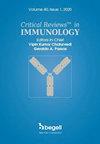全身免疫炎症指数和 T 细胞亚群在败血症严重程度和预后中的价值
IF 0.9
4区 医学
Q4 IMMUNOLOGY
引用次数: 0
摘要
全身免疫炎症指数(SII)和 T 细胞亚群与败血症患者的死亡风险有关,我们探讨了它们在败血症中的预测价值。受试者被分为败血症组(SP)/败血症休克组(SSP)/败血症休克组(SPS)。用全自动血液生化分析仪/流式细胞仪/Countess II FL全自动血细胞分析仪测量T细胞亚群[T辅助细胞(Th)1、Th2、调节性T细胞(Treg)、Th17]/血小板(PLT)/中性粒细胞(NEU)/淋巴细胞(LYM)/C反应蛋白(CRP)/降钙素原(PCT)/白细胞介素(IL)-4/IL-10/纤维蛋白原(FIB),并计算SII。使用 Spearman/ROC 曲线/卡普兰-梅耶尔分析了 SII/T 细胞亚群与急性生理学和慢性健康评估(APACH)II/序贯器官衰竭评估(SOFA)评分之间的相关性,以及 SII/Th1/Th2 对脓毒症诊断/预后的预测价值。三组患者的 PLT/NEU/LYM/CRP/PCT/IL-4/IL-10/FIB 水平和 APACH II/SOFA 评分各不相同。与 SP 组相比,其他两组的 APACH II/SOFA 评分和 SII/Th1/Th2/Th17/Treg 水平均有所升高。SII/Th1/Th2 水平与 APACH II/SOFA 评分呈显著正相关。SII/Th1/Th2水平对脓毒症的诊断/预后具有很高的预测价值,两者的组合具有更高的预测价值。SII/Th1/Th2水平高的脓毒症患者存活率较低。总之,SII、Th1 和 Th2 对不同严重程度脓毒症患者的诊断和预后具有很好的预测价值,它们的高水平会增加脓毒症患者的死亡率。本文章由计算机程序翻译,如有差异,请以英文原文为准。
The value of systemic immune-inflammation index and T cell subsets in the severity and prognosis of sepsis
Systemic immune-inflammation index (SII) and T cell subsets show involvement in mortality risk in septic patients, and we explored their predictive value in sepsis. Subjects were categorized into the Sepsis (SP)/Septic Shock (SSP)/Septic Shock (SPS) groups. T cell subsets [T-helper (Th)1, Th2, regulatory T cells (Treg), Th17]/platelets (PLT)/neutrophils (NEU)/lymphocytes (LYM)/C-reactive protein (CRP)/procalcitonin (PCT)/interleukin (IL)-4/IL-10/fibrinogen (FIB) were measured by an automatic blood biochemical analyzer/flow cytometry/Countess II FL automatic blood cell analyzer, with SII calculated. The correlations between SII/T cell subsets with Acute Physiology and Chronic Health Evaluation (APACH) II/Sequential Organ Failure Assessment (SOFA) scores and the predictive value of SII/Th1/Th2 for septic diagnosis/prognosis were analyzed using Spearman/ROC curve/Kaplan-Meier. The three groups varied in PLT/NEU/LYM/CRP/PCT/IL-4/IL-10/FIB levels and APACH II/SOFA scores. Compared with the SP group, the other two groups showed elevated APACH II/SOFA scores and SII/Th1/Th2/Th17/Treg levels. SII/Th1/Th2 levels significantly positively correlated with APACH II/SOFA scores. SII/Th1/Th2 levels had high predictive value for septic diagnosis/prognosis, with their combination exhibiting higher predictive value. Septic patients with high SII/Th1/Th2 levels exhibited lower survival rates. Altogether, SII, Th1, and Th2 had good predictive value for the diagnosis and prognosis of patients with varying severity of sepsis, with their high levels increasing mortality in septic patients.
求助全文
通过发布文献求助,成功后即可免费获取论文全文。
去求助
来源期刊
CiteScore
2.60
自引率
0.00%
发文量
14
审稿时长
>12 weeks
期刊介绍:
Immunology covers a broad spectrum of investigations at the genes, molecular, cellular, organ and system levels to reveal defense mechanisms against pathogens as well as protection against tumors and autoimmune diseases. The great advances in immunology in recent years make this field one of the most dynamic and rapidly growing in medical sciences. Critical ReviewsTM in Immunology (CRI) seeks to present a balanced overview of contemporary adaptive and innate immune responses related to autoimmunity, tumor, microbe, transplantation, neuroimmunology, immune regulation and immunotherapy from basic to translational aspects in health and disease. The articles that appear in CRI are mostly obtained by invitations to active investigators. But the journal will also consider proposals from the scientific community. Interested investigators should send their inquiries to the editor before submitting a manuscript.

 求助内容:
求助内容: 应助结果提醒方式:
应助结果提醒方式:


